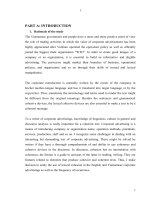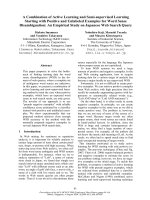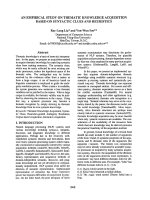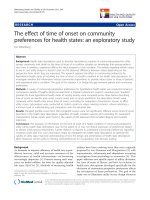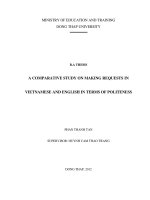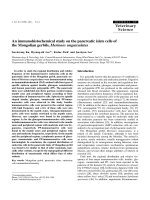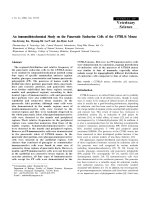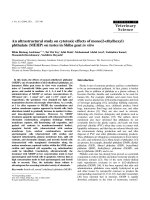Customers online purchasing intention_ an exploratory study on affecting factors in Vietnam
Bạn đang xem bản rút gọn của tài liệu. Xem và tải ngay bản đầy đủ của tài liệu tại đây (1.37 MB, 101 trang )
MINISTRY OF EDUCATION AND TRANNING
UNIVERSITY OF ECONOMICS HO CHI MINH CITY
------------
TRẦN THANH SƠN
CUSTOMER’S ONLINE PURCHASING
INTENTION: AN EXPLORATORY STUDY ON
AFFECTING FACTORS IN VIETNAM
THESIS OF MASTER OF BUSINESS ADMINISTRATION
HO CHI MINH CITY – 2013
MINISTRY OF EDUCATION AND TRANNING
UNIVERSITY OF ECONOMICS HO CHI MINH CITY
------------
TRẦN THANH SƠN
CUSTOMER’S ONLINE PURCHASING
INTENTION: AN EXPLORATORY STUDY ON
AFFECTING FACTORS IN VIETNAM
Subject
: Master of Business Administration
Code
: 60.34.01.02
THESIS OF MASTER OF BUSINESS ADMINISTRATION
ADVISOR: DR. TRẦN HÀ MINH QUÂN
HO CHI MINH CITY – 2013
i
ACKNOWLEDGEMENT
For the successful completion of this thesis, I would like to show my
sincere thanks to all those who have supported me during the time I conducted
the study.
First of all, I would like to express my deepest gratitude to my advisor,
Dr. Tran Ha Minh Quan, for his generous and patient guidance to my thesis.
His inspiring advices are essential and valuable for me to finish this thesis. The
advisor is very knowledgeable, and nice to me all the time. I feel very lucky
appreciate him to give a chance to be his student.
Secondly, I would like to extend my sincere thanks to respectful lecturers
of University of Economics Ho Chi Minh city, who have empowered me with
considerably useful knowledge during the time I studied in University.
Thirdly, I would like to send special thanks to my friends, students of the
eMBA course of University of Economics Ho Chi Minh city for kindly helping
me collect useful information for the study. Specially, Tran Cong Tan, he
always encourages me when I have trouble duration of carrying out thesis.
Fourly, I would like to send special thanks to Dang Huu Phuc for his
strong support in the completion of the thesis.
Lastly, I would like the send the most special thanks to my family, who
always help me with so much love, care and encouragement.
Although I have tried my best to complete my thesis, but errors could not
be avoided. Therefore, I am looking forward to receiving the comments from
respectful lectures and friends, so that my thesis could be more improved.
Trần Thanh Sơn
Ho Chi Minh, December, 2013
ii
COMMITMENT
I hereby would like to commit that the thesis, “Customers’ online purchasing
intention: an exploratory study on affecting factors in Vietnam”, was accomplished
based on my independent and serious studies and researches. The data was collected
in reality and it has clear origins. In addition to that, the data would be trust-worthily
handled and it has never been released in any menu.
Trần Thanh Sơn
iii
ABSTRACT
Vietnam has witnessed rapid development of Internet, in terms of infrastructure,
users and internet-based services. As for Vietnamese people, Internet gradually
becomes a very important channel for shopping, introducing products and services,
characterized by the surging numbers of online transactions. It inspired the need to
study the issues related to the intention of customers for online purchasing.
The purpose of the thesis is to study the main factors influencing the intention of
customers when they carry out the online shopping. The study is based on the data
which is collected through google document.
Usefulness, Ease of Use and Security are three important factors influencing
Vietnamese customer attitude as they purchase online. Attitude, Normative Beliefs
and Usefulness were identified as three important factors influencing Vietnamese
customer’s online purchasing intention.
iv
Table of Content
ACKNOWLEDGEMENT .......................................................................................... i
COMMITMENT ........................................................................................................ ii
ABSTRACT .............................................................................................................. iii
LIST OF FIGURES.................................................................................................. vii
LIST OF TABLES .................................................................................................. viii
CHAPTER 1. INTRODUCTION TO THE STUDY ..................................................1
1.1. Research background .......................................................................................1
1.2. Problem statement ............................................................................................5
1.3. Research questions and research objectives.....................................................6
1.4. Significances of the research:...........................................................................7
1.5. Research scope .................................................................................................7
1.6. Research structure ............................................................................................8
CHAPTER 2. LITERATURE REVIEW ....................................................................9
2.1. E-commerce .....................................................................................................9
2.2. Theory of Reasoned Action (TRA) ..................................................................9
2.3. Theory of Planned Behavior (TPB) ...............................................................11
2.4. Technology Acceptance Model (TAM) .........................................................12
2.5. Salient Beliefs of Usefulness and Ease of Use ..............................................14
2.6. Salient Beliefs of Compatibility, Privacy and Security .................................14
2.7. Salient Beliefs Normative-Beliefs and Self-Efficacy ....................................15
2.8. Research model ..............................................................................................16
CHAPTER 3. RESEARCH METHODOLOGY ......................................................20
3.1. Research design ..............................................................................................20
3.2. Pilot study.......................................................................................................21
3.3. Measurement ..................................................................................................21
3.4. Research sampling .........................................................................................23
v
3.4.1. Target population ....................................................................................23
3.4.2. Sample size..............................................................................................23
3.5. Collecting data ...............................................................................................24
3.6. Data Cleaning .................................................................................................24
3.7. Methods of data analysis ................................................................................25
3.7.1. Reliability assessment of measurement scales (Cronbach alpha) ...........25
3.7.2. Explore Factor Analysis (EFA)...............................................................26
3.7.3. Multi Linear Regression (MLR) .............................................................26
3.8. Summary ........................................................................................................27
CHAPTER 4. RESULTS AND DISCUSION ..........................................................28
4.1. Descriptions of sample ...................................................................................28
4.2. Reliability and validity of the measurement scale .........................................30
4.2.1. Reliability testing (Cronbach Alpha) ......................................................30
4.2.2. Exploratory Factor Analysis ...................................................................32
4.2.2.1. EFA implementation for independent variable ................................33
4.2.2.2. EFA implementation for dependent variable ...................................35
4.3. The Modified Theoretical Framework and Hypotheses Restatement............35
4.3.1. The Modified Theoretical Framework ....................................................35
4.3.2. Hypotheses restatement ...........................................................................38
4.4. Research Hypothesis Testing .........................................................................39
4.4.1. The first multiple regression analysis .....................................................39
4.4.2. The second multiple regression analysis .................................................41
4.4.3. Results of testing the hypotheses ............................................................43
4.5. Summary ........................................................................................................44
CHAPTER 5. CONCLUSION AND RECOMMENDATION ................................46
vi
5.1. Discussion of Study Finding ..........................................................................46
5.2. Practical implication.......................................................................................47
5.3. Limitations and future research ......................................................................48
LIST OF REFERENCE ............................................................................................50
APPENDIX 1 ............................................................................................................56
APPENDIX 2 ............................................................................................................65
APPENDIX 3 ............................................................................................................74
APPENDIX 4 ............................................................................................................80
vii
LIST OF FIGURES
Figure 2.1. Theory of Reasoned Action from Davis, Bagozzi et Warshaw (1989) ..10
Figure 2.2. Theory of planned behavior ....................................................................12
Figure 2.3. Technology acceptance model (adopted from Davis, Bagozzi & Warshaw
1989)..........................................................................................................................13
Figure 2.4. Research Model ......................................................................................17
Figure 4.1. Modified theoretical framework .............................................................38
Figure 4.2. The updated research model ...................................................................44
viii
LIST OF TABLES
Table 3-1. Measurement scales of research ..............................................................22
Table 4-1. Statistical summary of socio – demographic variables ...........................29
Table 4-2. Cronbach alpha coefficients ....................................................................31
Table 4-3.EFA implementation for independent variables .......................................34
Table 4-4.Cronbach Alpha coefficient of 5 group ....................................................34
Table 4-5. EFA implementation for dependent variables .........................................35
Table 4-6. Seven new factor in the research model ..................................................36
Table 4-7. Model Summary of first multiple linear regression ................................40
Table 4-8. ANOVA of first multiple linear regression .............................................40
Table 4-9. Coefficient of independent variables in first multiple linear regression .40
Table 4-10. Model Summary of first multiple linear regression ..............................41
Table 4-11. ANOVA of first multiple linear regression ...........................................42
Table 4-12. Coefficient of independent variables in first multiple linear regression42
Table 4-13. Summary of restatement hypotheses testing result ...............................43
1
CHAPTER 1. INTRODUCTION TO THE STUDY
1.1. Research background
During these last few years, information and communication technology
substantially increased the possibilities of playing, communicating and making
transactions, etc. (Singh 1996). Today Internet is not only a networking media, but
also as transaction medium for consumers at global market in the world, and becomes
dominant retailers in the future (Yulihasri et al. 2011). The coming into being of
Internet has been changing the traditional ways of purchasing goods of human beings.
The users have no longer been restricted by time and geographical factors. They could
actively buy the products and goods regardless of any time and location factors.
Internet has brought about news methods of communication and new ways of
exchanging everyday information between people. The ever increasing number of
Internet users would also coincide with the development of online purchasing (Joines,
Schere & Scheufele, 2003). Electronic commerce, normally known as E-commerce,
involves of the buying and selling of product or services over electronic systems such
as the Internet and other computer networks. A wide variety of commerce is
conducted in this way, spurring and drawing on innovations in electronic funds
transfer, supply chain management, Internet marketing, online transaction
processing, electronic data interchange, inventory management systems, and
automated data collection systems. Modern E-commerce typically uses the World
Wide Web at least at some point in the transaction's lifecycle, although it can circle a
wider range of technologies such as e-mail as well. E-commerce that is conducted
between businesses is referred to as business-to-business or B2B. B2B can be open
to all interested parties (e.g. commodity exchange) or limited to specific, prequalified participants (private electronic market). E-commerce that is conducted
between businesses and consumers, on the other hand, is referred to as business-toconsumer or B2C. This is the type of E-commerce conducted by companies such as
Amazon.com. The most necessary element of e-retail offers a direct interactive
channel as well as no time definition, people and place.
2
Online shopping is the process whereby consumers directly buy goods or
services from a seller in real-time, without an intermediary service, over the Internet.
Online shopping is a type of E-commerce used for business-to-business (B2B) and
business-to-consumer (B2C) transactions. Shopping on Internet becomes an
alternative for consumers since it is more comfortable than conventional shopping
which usually attributed with anxious, crowded, traffic jam, limited time, parking
space and etc… ( Yulihasri et al. 2011).
Using Internet for purchasing goods has become a key component of business
strategies. In principle, the internet can be used to facilitate purchase transactions
among all kinds of actors: among consumers, among businesses, between businesses
and consumers. But by far the biggest and most successful area of application has
been in the business-to-business domain. In the business-to-consumer area, business
development has been more concentrated on certain niche areas (Butler & Peppard
1998). Many of the sites run with a deficit or have even had to close down. Especially
in connection with the sale of food and other products for daily use on the internet,
there have been few breakthrough successes. According to the U. S. Department of
Commerce (2004, 2006a, 2006b, 2007) total retail e-commerce sales in 2007 were
$136 billion, an increase of 25.6% from the previous year and an amazing 207%
increase compared to 2002. E-commerce sales as a percentage of total retail sales also
continued to increase and, for 2007, were at 3.3% of total retail sales. Despite the
continued growth in e-commerce and the potential for future growth in E-commerce,
companies have reported problems in attracting new customers and retaining existing
ones (Devaraj, Fan & Kohli 2002) and face challenges in converting online visitors
to real purchasers (Chen 2003).
Purchasing intention is a psychological process of decision-making (Engel et al.
1990). Consumers are motivated by the fulfillment of demands to search relevant
information according to personal experience and the external environment. They
begin to evaluate and consider after accumulating a certain amount of information.
Finally, they make the decision on certain products after comparison and judgment.
3
This is known as the “purchasing decision process” of consumers. Purchasing
intention is the probability of customer’s willingness to purchase (Dodds et al. 1991).
And the higher perceived value, the more purchasing intention. Because of the rapid
growth of the Internet and its use as a channel for shopping, today’s consumers are
able to shop from anywhere at any time with just a few clicks of their fingers.
In Viet Nam, E-commerce and the IT industry are given our fair share of attention
and support. Recent initiatives taken by the Vietnam government toward boosting
this sector include the formation of the E-commerce Board, the introduction of a new
Internet management decree, entering into the E-ASEAN Framework Agreement,
and the lowering of Internet access charges.
According to Vietnam NetCitizens report (Cimigo 2011), the number of Internet
users in Vietnam accounted for 31% of the total population in 2010. The percentage
is similar to some other countries like China, the Philippines and Thailand. Over the
past few years, in comparison with other countries in the region, we have witnessed
rapid development of Internet in Vietnam and Vietnam becomes a country whose
Internet development ranked top of the world.
Over 50% of urban population had their Internet connections in the urban areas
(including 12 cities mentioned in Cimigo (2011)). According to information
publicized in the Vietnam E-commerce report 2011 by Ministry of Industry and
Commerce, 100% of surveyed enterprises were equipped with computers, 98% were
connected with Internet with different ways, in which 89% had their broadband
technology connections (ADSL). Over 81% of enterprises used e-mails in their
business and manufacturing activities, the number was 96% for big enterprises and
80% for small and medium enterprises. According to the survey, the percentage of
enterprises accepted the bookings via e-mails accounted for 52% and the number was
15% for website-based bookings, the percentage of enterprises made the bookings
via e-mails accounted for 53% and the number was 21% for website-based bookings.
The enterprises were also aware and paid much attention to the development and
promotion of their images and products in the Internet environment by developing
4
their own websites; participating in e-commerce portals, social networks; advertising
in e-newspapers and famous searching engines like google.com, yahoo.com…
Statistics showed that 38% of enterprises developed their own websites, 14%
participated in e-commerce portals.
Vietnamese users are becoming more familiar with online shopping activities
provided by domestic and oversea websites. Over the past few years, online shopping
enjoys strongest growth rate in comparison with other businesses. According to the
Vietnam NetCitizens report carried out by Cimigo (2011), online shopping volume
was doubled since 2007.
Vietnamese customers are also more familiar with electronic payment systems,
which is a very important factor of online shopping. At the present moment,
customers have many options to choose the electronic payment gateways when they
purchase online. Some payment gateways are highly trusted becoming popular, such
as NganLuong, BaoKim, VNPay, Payoo, OnePay… Thanks to the development of
these electronic payment gateways, Vietnamese individuals and enterprises could
easily develop Internet-based websites selling and buying products and services. The
selling process is automated in a higher level as transactions could be totally
completed online, replacing the previous method in which the products are introduced
in the Internet and the cash is collected after the delivery of product.
Many big foreign companies are looking for business opportunities in the ecommerce market of Vietnam. Some of the big names in the world, such as Google,
Alibaba, Rakuten, eBay and Amazon, quickly promote their appearance in the
market. In June 2012, Google became member of Vietnam E-commerce Association
and had their plans to develop online shopping activities with other members. They
expected that they could earn 30 million USD per year in Vietnam market, in which
their potential customers are small and medium-sized enterprises.
The official representative of Alibaba was announced while eBay just bought
20% of Peacesoft Solution’s shares, who is the owner of the website chodientu.com.
Amazon already approached domestic e-commerce service providers to explore the
5
opportunities to buy the shares or become their partners. This would be the catalyst
for the development of Vietnam e-commerce.
Although the number of Internet users is huge and ever increasing, the majority
of them only use Internet to look for information and communications (Cimigo 2011).
Internet plays an important role in choosing and buying the products, but the trust is
still low for online payment methods. Buying Internet-based products is still not
popular in Vietnam.
The other obstacle is low awareness of Vietnamese people and the unfriendliness
of the social environment and business practices. Although enterprises are very active
in applying information technology and e-commerce, more time spans and necessary
steps are needed to achieve advanced business and consumption environment.
Online security and privacy is still not ensured. It shows a fact that enterprises
are aware of the importance of online security for the application of e-commerce.
1.2. Problem statement
With the development for E–commerce, many products have sold. Various
goods, including books, CDs, DVDs, hobby-related goods, clothing items, event
tickets, electronic goods, and even food items are being sold at online shops.
However, some people regularly make purchases at online shops, but some others do
not, even if they regularly use the Internet. Some consumers do not purchase goods
at online shops even when prices are low and orders are easy to submit. The question
about the reasons behind consumers’ reluctance to opt for online purchasing needs to
concern of many. To increase the understanding in this area, it’s very important to
have a correct answer for the question. To master actual situation of online shopping
in Vietnam, I study the thesis: “Customers’ online purchasing intention: an
exploratory study on affecting factors in Vietnam”. This study want to know the
reasons, why the Vietnamese accept or refuse internet shopping application? And
what are dominant factors that influence the customer to shop on internet in Vietnam.
The necessary to do is to identify the factors affecting customer’s purchasing
intention in online environment in Vietnam. Through the review of previous studies,
6
author used the paper “Factors that influence customers’ buying intention on
shopping online” (Yulihasri et al.2011) as the key paper to refer. In this paper,
Yulihasri et al (2011) used model research from research of Vijayasarathy (2003) to
investigate in Malaysia. In theoretical framework of Vijayasarathy (2003), factors
affecting customer’s online buying intention are usefulness, ease of use,
compatibility, privacy, security, normative beliefs, self-efficacy, and attitude.
However, in Vietnam, what are factors that affect customer’s online purchasing
intention, those are also similarly or not. With this thesis, author would like to clarify
these issues.
1.3. Research questions and research objectives
In this study, author examines the factors affect online shopping in Vietnam. The
study aims at answering the below 2 research questions:
Question 1: Which factors affects attitude and intention of Vietnamese
customers when they purchase online?
Question 2: How do these factors influence the attitude and intention of
Vietnamese customers when they purchase online?
The research objectives of this study is conducted to identify factors influencing
attitude and intention of customers towards online shopping in Vietnam. It seeks to
examine and understand whether factors such as usefulness, ease of use,
compatibility, privacy, security, normative beliefs, self-efficacy, attitude influent
customers’ purchase online intention. The specific objectives are:
To examine the relationship between usefulness and customer’s attitude.
To examine the relationship between ease of use and customer’s attitude.
To examine the relationship between compatibility and customer’s
attitude.
To examine the relationship between privacy and customer’s attitude.
To examine the relationship between security and customer’s attitude.
To examine the relationship between usefulness and customer’s online
purchasing intention.
7
To examine the relationship between normative beliefs and customer’s
online purchasing intention.
To examine the relationship between self - efficacy and customer’s online
purchasing intention.
To examine the relationship between attitude and online purchasing
intention of customer.
1.4. Significances of the research:
The results of the study are practically meaningful for e-commerce in Vietnam.
Assist managers and traders of Internet-based products/services to master the main
factors influencing online shopping intention of Vietnamese customers. This study
helps e retailers adjust their e-retailing strategies by learning this research results. The
expectation of this study is to provide relevant results to the e-retail company to
engage the customers to shop online and to help the sellers to keep their current
customers and attract new potential ones.
This study will also provide compulsory knowledge for people who are doing
their e-commerce business in Vietnam, which is new and lack of official studies on
this field in Vietnam.
1.5. Research scope
First, this study would focus on the satisfaction of Vietnamese customers when
they purchase online, regardless of the geographical locations of the buyers.
Second, to ensure that the surveyed customers could be able to provide adequate
information for the study, only customers who educated from high school, university,
college was chosen to participate in the survey. This choice of population and sample
frame makes the study feasible (given time and resource limitation) by facilitating
online survey method.
8
1.6. Research structure
Chapter 1: Introduction will provide the research background, problem
statement, research questions objectives, significances of the research as well as
research scope.
Chapter 2: Literature review provides theoretical and empirical background and
the hypothesized research model.
Chapter 3: Methodology gives the methodologies the author use to conduct this
research.
Chapter 4: Results are conducted based on the collected data to test the
hypotheses and answer the research questions.
Chapter 5: Conclusion; author provides practical implication, and possible
directions for future research.
9
CHAPTER 2. LITERATURE REVIEW
This chapter presents the theories behind customer intention. It will also discuss
online purchasing intention of customer in order to identify influencing factors. The
research framework and hypotheses will also be proposed in this chapter.
2.1. E-commerce
Most creative technology that has reached a big impact at all of us is Internet
innovation. Yu and Abdulai (2000) mentioned that the most significant result of the
rapid innovations in information and communication technology is electroniccommerce. What is e-commerce? E-commerce basically refers to trade that takes
place over the Internet where a buyer visits a seller’s web site, orders and makes the
payment of the product over the internet and finally, goods are delivered physically
to the customers. Anil (2000) said that electronic commerce is an important part of
the growth of the Internet. Brown, Pope and Voges (2003) mentioned that the key
feature of e-retailing, the consumers is facilitated by information with regard to
product attributes, comparative pricing, availability and overall value added.
According to Oinas (2002) internet retailing seems to be growing in all places on the
world, including developing countries. There were many changes taking place in the
business in connection with the technological opportunities provided by the Internet
which in the future it becomes the dominant shopping practically.
2.2. Theory of Reasoned Action (TRA)
The Theory of Reasoned Action (TRA) is a model that finds its origins in the
field of social psychology. This model developed by Fishbein and Ajzen (1975)
defines the links between beliefs, attitudes, norms, intentions, and behaviors of
individuals. According to this model, a person’s behavior is determined by its
behavioral intention to perform it. This intention is itself determined by the person’s
attitudes and his subjective norms towards the behavior. Fishbein and Ajzen (1975,
p. 302) define the subjective norms as “the person’s perception that most people who
10
are important to him think he should or should not perform the behavior in question”
(Fishbein & Ajzen 1975, p.302)
This theory can be summarized by the following equation:
Behavioral Intention = Attitude + Subjective norms
According to TRA, the attitude of a person towards a behavior is determined by
his beliefs on the consequences of this behavior, multiplied by his evaluation of these
consequences. Beliefs are defined by the person’s subjective probability that
performing a particular behavior will produce specific results. This model therefore
suggests that external stimuli influence attitudes by modifying the structure of the
person’s beliefs. Moreover, behavioral intention is also determined by the subjective
norms that are themselves determined by the normative beliefs of an individual and
by his motivation to comply to the norms.
Figure 2.1. Theory of Reasoned Action from Davis, Bagozzi et Warshaw (1989)
TRA also claims that all other factors which influence the behavior only do so in an
indirect way by influencing the attitude or subjective norms. Fishbein and Ajzen
(1975) refer to these factors as being external variables. These variables can be for
example, the characteristics of the tasks, of the interface or of the user, the type of
development implementation, the political influences, the organizational structure,
etc. (Davis, Bagozzi & Warshaw 1989). A meta-analysis on the application of the
theory of reasoned action showed that the model can produce good predictions of
11
choices made by an individual when facing several alternatives (Sheppard, Hartwick
&Warshaw 1988).
2.3. Theory of Planned Behavior (TPB)
A center factor in Theory of Planned Behavior, TPB, (Ajzen 1985; Ajzen 1991)
is determined by individual intention to execute the behavior. The intention is
proposed to explain factors that influencing behavior. TPB is an extension of the
Theory of reasoned action. According to the author, the need for this new model
results from limitations on behaviors on which people had little control. Ajzen added
therefore a third element to his model, which according to him has an influence on a
person’s intention to perform a behavior which he called perceived behavioral
control. Perceived behavioral control refers to readily available resources, skills, and
opportunities as well as the person’s own perception towards the importance of
achieving the results. The concept of Perceived Behavioral Control is close to the
concept of self-efficacy of Bandura (1982). Beliefs of an individual concerning his
self-efficacy can have an influence on his choice of activities, his preparation for the
activity and finally on the effort that he will exert during the activity in question.
Ajzen and Madden (1985) found that perception of control, like attitude towards the
behavior and subjective norm can have an important impact on an individual’s
behavioral motivation. Perceived behavior control, the importance of behavior
control, is self-evident and refers to people’s perception of the ease or difficulty
performs the interest behavior (Ajzen & Madden 1985). According to the theory of
planned behavior that the behavior is a joint function with intentions and perceived
control behavioral. The two perceptions and intention conduct behavior can make
important contribution to behavior prediction. Ajzen (1991) mentioned that the
central factor in the TBP is the person’s intention to perform a behavior. Intention is
assumed to capture the motivational variables that influence a behavior. They are
indications of how hard people are willing to perform the behavior. In addition, the
stronger the intention to engage in a behavior, the more likely must be its performance
12
Figure 2.2. Theory of planned behavior
2.4. Technology Acceptance Model (TAM)
Based on the theory of reasoned Action, Davis (1989) developed the Technology
Acceptance Model which deals more specifically with the prediction of the
acceptability of an information system. The purpose of this model is to predict the
acceptability of a tool and to identify the modifications which must be brought to the
system in order to make it acceptable to users. A key purpose of TAM is to provide
a basis for tracing the impact of external factors on internal beliefs, attitude and
intention, more TAM consist that two particular beliefs, perceived usefulness and
perceived ease of use are primary relevance for computer acceptance behaviors,
(Davis, Bagozzi & Warshaw 1989). Usefulness, ease of use is expected that they can
be influence individual’s attitude at using that system; they also explain difference
intention to use that system.
Perceived usefulness is defined as being the degree to which a person believes
that the use of a system will improve his performance. Perceived ease of use refers to
the degree to which a person believes that the use of a system will be effortless.
Several factorial analyses demonstrated that perceived usefulness and perceived ease
13
of use can be considered as two different dimensions (Hauser & Shugan 1980;
Larcker & Lessig 1980 ).
As demonstrated in the Theory of Reasoned Action, the Technology Acceptance
Model postulates that the use of an information system is determined by the
behavioral intention, but on the other hand, that the behavioral intention is determined
by the person’s attitude towards the use of the system and also by his perception of
its utility. According to Davis, the attitude of an individual is not the only factor that
determines his use of a system, but is also based on the impact which it may have on
his performance. Therefore, even if an employee does not welcome an information
system, the probability that he will use it is high if he perceives that the system will
improve his performance at work. The Technology Acceptance Model also figures in
a harmony link between ease of use and usefulness, proposed individual’s perception
how easy or difficult to use that system will influence their perception about
usefulness of that system (Vijayasarathy 2003).
Vijayasarathy (2003) furthermore mentioned a set of variables in TAM possible
for explaining technology adoption at work, where usage at the time of technology in
most cases, compulsory its user, otherwise was compelled. In good arrangement, felt
usefulness and ease of use are good for possible dominant predictor.
Figure 2.3. Technology acceptance model (adopted from Davis, Bagozzi &
Warshaw 1989)
14
2.5. Salient Beliefs of Usefulness and Ease of Use
According to Davis (1989) perceived ease of use also influences in a significant
way the attitude of an individual through two main mechanisms: self-efficacy and
instrumentality. Self-efficacy is a concept developed by Bandura (1982) which
explains that the more a system is easy to use, the greater should be the user’s sense
of efficacy. Moreover, a tool that is easy to use will make the user feel that he has a
control over what he is doing (Lepper 1982). Efficacy is one of the main factors
underlying intrinsic motivation (Bandura 1982; Lepper 1982) and it is what illustrates
here the direct link between perceived ease of use and attitude. Perceived ease of use
can also contribute in an instrumental way in improving a person’s performance. Due
to the fact that the user will have to deploy less efforts with a tool that is easy to use,
he will be able to spare efforts to accomplish other tasks. (Davis 1989).
It is however interesting to note that the research presented by Davis (1989) to
validate his model, demonstrates that the link between the intention to use an
information system and perceived usefulness is stronger than perceived ease of use.
In other hand, usefulness was significantly more strongly associated to usage than
was ease of use.
Ramayah, Aafaqi and Jantan (2003) found perceived usefulness and perceived
ease of use have significant impacts student’s acceptance and usage of course online
among higher education institution student and when perceived ease of use and
perceived usefulness are combined together was found that perceived usefulness acts
as partial mediator.
2.6. Salient Beliefs of Compatibility, Privacy and Security
Chau and Hwa (2001) identified compatibility as a necessary factor for
innovation adoption also included in the decomposed model. The effect of
compatibility on user technology acceptance decisions has been reported by many
previous studies reported a strong relationship between compatibility and relative
advantage. Karyanni (2003) found also that compatibility was successful in
distinguishing between Web shopper and non-shopper. Anil (2000) explained that
15
Internet shopping activities often lead to several ways of processing personal data.
Protecting the privacy is very important and these personal data are used with care,
required for legitimate purposes. They were not disclosed to the wrong people and
not processed without agreement of the person concerned. Therefore, the processing
of personal data should be to deal with certain conditions Fatimah (2000). Ramayah,
Dahlan, Teck and Aafaqi (2003) described that the major barrier to adoption of eretail belief on the security and privacy issues. Besides, the technology has to be
improved, the users have to be convinced and guaranteed of their security and privacy
for growing internet shopping.
Security concerns are one of the main reasons why web users are not purchasing
over the Internet. Udo (2001) mentioned that, there is a close relationship between
security and privacy. While privacy is related to what a company purposely decides
to do with consumer data, security is concerned with any accidental comprises of
consumer data to a third party (e.g.Hacker and identify thief) and Salim (2000)
mentioned that we have to realize that in that future, the hackers are not from inside
the company but also it can be from outside or somewhere else where can not identify.
Consumers’ privacy issues are not new and consumer have worried about how
personal data are used by government and more recently by business. Internet users
want to feel that their privacy are being protected. The government must also protect
the privacy and security of consumers as one of the main roles it can contribute in
growing internet shopping, Yu and Abdulai (2000).
2.7. Salient Beliefs Normative-Beliefs and Self-Efficacy
Ajzen (1991) mentioned normative-beliefs include three kinds of salient beliefs
are distinguished: behavioral belief which are assumed to influence attitudes toward
behavior, normative beliefs which constitute the underlying determinants of
subjective norms and control beliefs which provide the basis for perceptions of
behavioral control. Budd (1985) found also personal normative-beliefs significantly
contribute to the theory of reason’s predictive power, a variable which mediates the
relationship between attitudes, subjective norm and intention.
